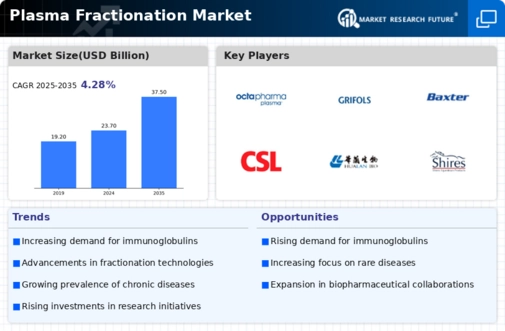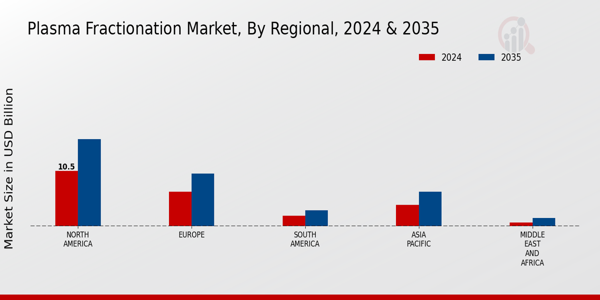Immunoglobulin
Albumin
Coagulation Factors
Protease Inhibitors
Neurology
Hematology
General Medicine
Immunology
Hospitals
Ambulatory Surgical Centers
Blood Banks
Pharmaceutical Companies
Centrifugation
Chromatography
Precipitation
Filtration
North America
Europe
South America
Asia Pacific
Middle East and Africa
North America Outlook (USD Billion, 2019-2035)
North America Plasma Fractionation System Market by Product Type
Immunoglobulin
Albumin
Coagulation Factors
Protease Inhibitors
North America Plasma Fractionation System Market by Application Type
Neurology
Hematology
General Medicine
Immunology
North America Plasma Fractionation System Market by End User Type
Hospitals
Ambulatory Surgical Centers
Blood Banks
Pharmaceutical Companies
North America Plasma Fractionation System Market by Technology Type
Centrifugation
Chromatography
Precipitation
Filtration
North America Plasma Fractionation System Market by Regional Type
US
Canada
US Outlook (USD Billion, 2019-2035)
US Plasma Fractionation System Market by Product Type
Immunoglobulin
Albumin
Coagulation Factors
Protease Inhibitors
US Plasma Fractionation System Market by Application Type
Neurology
Hematology
General Medicine
Immunology
US Plasma Fractionation System Market by End User Type
Hospitals
Ambulatory Surgical Centers
Blood Banks
Pharmaceutical Companies
US Plasma Fractionation System Market by Technology Type
Centrifugation
Chromatography
Precipitation
Filtration
CANADA Outlook (USD Billion, 2019-2035)
CANADA Plasma Fractionation System Market by Product Type
Immunoglobulin
Albumin
Coagulation Factors
Protease Inhibitors
CANADA Plasma Fractionation System Market by Application Type
Neurology
Hematology
General Medicine
Immunology
CANADA Plasma Fractionation System Market by End User Type
Hospitals
Ambulatory Surgical Centers
Blood Banks
Pharmaceutical Companies
CANADA Plasma Fractionation System Market by Technology Type
Centrifugation
Chromatography
Precipitation
Filtration
Europe Outlook (USD Billion, 2019-2035)
Europe Plasma Fractionation System Market by Product Type
Immunoglobulin
Albumin
Coagulation Factors
Protease Inhibitors
Europe Plasma Fractionation System Market by Application Type
Neurology
Hematology
General Medicine
Immunology
Europe Plasma Fractionation System Market by End User Type
Hospitals
Ambulatory Surgical Centers
Blood Banks
Pharmaceutical Companies
Europe Plasma Fractionation System Market by Technology Type
Centrifugation
Chromatography
Precipitation
Filtration
Europe Plasma Fractionation System Market by Regional Type
Germany
UK
France
Russia
Italy
Spain
Rest of Europe
GERMANY Outlook (USD Billion, 2019-2035)
GERMANY Plasma Fractionation System Market by Product Type
Immunoglobulin
Albumin
Coagulation Factors
Protease Inhibitors
GERMANY Plasma Fractionation System Market by Application Type
Neurology
Hematology
General Medicine
Immunology
GERMANY Plasma Fractionation System Market by End User Type
Hospitals
Ambulatory Surgical Centers
Blood Banks
Pharmaceutical Companies
GERMANY Plasma Fractionation System Market by Technology Type
Centrifugation
Chromatography
Precipitation
Filtration
UK Outlook (USD Billion, 2019-2035)
UK Plasma Fractionation System Market by Product Type
Immunoglobulin
Albumin
Coagulation Factors
Protease Inhibitors
UK Plasma Fractionation System Market by Application Type
Neurology
Hematology
General Medicine
Immunology
UK Plasma Fractionation System Market by End User Type
Hospitals
Ambulatory Surgical Centers
Blood Banks
Pharmaceutical Companies
UK Plasma Fractionation System Market by Technology Type
Centrifugation
Chromatography
Precipitation
Filtration
FRANCE Outlook (USD Billion, 2019-2035)
FRANCE Plasma Fractionation System Market by Product Type
Immunoglobulin
Albumin
Coagulation Factors
Protease Inhibitors
FRANCE Plasma Fractionation System Market by Application Type
Neurology
Hematology
General Medicine
Immunology
FRANCE Plasma Fractionation System Market by End User Type
Hospitals
Ambulatory Surgical Centers
Blood Banks
Pharmaceutical Companies
FRANCE Plasma Fractionation System Market by Technology Type
Centrifugation
Chromatography
Precipitation
Filtration
RUSSIA Outlook (USD Billion, 2019-2035)
RUSSIA Plasma Fractionation System Market by Product Type
Immunoglobulin
Albumin
Coagulation Factors
Protease Inhibitors
RUSSIA Plasma Fractionation System Market by Application Type
Neurology
Hematology
General Medicine
Immunology
RUSSIA Plasma Fractionation System Market by End User Type
Hospitals
Ambulatory Surgical Centers
Blood Banks
Pharmaceutical Companies
RUSSIA Plasma Fractionation System Market by Technology Type
Centrifugation
Chromatography
Precipitation
Filtration
ITALY Outlook (USD Billion, 2019-2035)
ITALY Plasma Fractionation System Market by Product Type
Immunoglobulin
Albumin
Coagulation Factors
Protease Inhibitors
ITALY Plasma Fractionation System Market by Application Type
Neurology
Hematology
General Medicine
Immunology
ITALY Plasma Fractionation System Market by End User Type
Hospitals
Ambulatory Surgical Centers
Blood Banks
Pharmaceutical Companies
ITALY Plasma Fractionation System Market by Technology Type
Centrifugation
Chromatography
Precipitation
Filtration
SPAIN Outlook (USD Billion, 2019-2035)
SPAIN Plasma Fractionation System Market by Product Type
Immunoglobulin
Albumin
Coagulation Factors
Protease Inhibitors
SPAIN Plasma Fractionation System Market by Application Type
Neurology
Hematology
General Medicine
Immunology
SPAIN Plasma Fractionation System Market by End User Type
Hospitals
Ambulatory Surgical Centers
Blood Banks
Pharmaceutical Companies
SPAIN Plasma Fractionation System Market by Technology Type
Centrifugation
Chromatography
Precipitation
Filtration
REST OF EUROPE Outlook (USD Billion, 2019-2035)
REST OF EUROPE Plasma Fractionation System Market by Product Type
Immunoglobulin
Albumin
Coagulation Factors
Protease Inhibitors
REST OF EUROPE Plasma Fractionation System Market by Application Type
Neurology
Hematology
General Medicine
Immunology
REST OF EUROPE Plasma Fractionation System Market by End User Type
Hospitals
Ambulatory Surgical Centers
Blood Banks
Pharmaceutical Companies
REST OF EUROPE Plasma Fractionation System Market by Technology Type
Centrifugation
Chromatography
Precipitation
Filtration
APAC Outlook (USD Billion, 2019-2035)
APAC Plasma Fractionation System Market by Product Type
Immunoglobulin
Albumin
Coagulation Factors
Protease Inhibitors
APAC Plasma Fractionation System Market by Application Type
Neurology
Hematology
General Medicine
Immunology
APAC Plasma Fractionation System Market by End User Type
Hospitals
Ambulatory Surgical Centers
Blood Banks
Pharmaceutical Companies
APAC Plasma Fractionation System Market by Technology Type
Centrifugation
Chromatography
Precipitation
Filtration
APAC Plasma Fractionation System Market by Regional Type
China
India
Japan
South Korea
Malaysia
Thailand
Indonesia
Rest of APAC
CHINA Outlook (USD Billion, 2019-2035)
CHINA Plasma Fractionation System Market by Product Type
Immunoglobulin
Albumin
Coagulation Factors
Protease Inhibitors
CHINA Plasma Fractionation System Market by Application Type
Neurology
Hematology
General Medicine
Immunology
CHINA Plasma Fractionation System Market by End User Type
Hospitals
Ambulatory Surgical Centers
Blood Banks
Pharmaceutical Companies
CHINA Plasma Fractionation System Market by Technology Type
Centrifugation
Chromatography
Precipitation
Filtration
INDIA Outlook (USD Billion, 2019-2035)
INDIA Plasma Fractionation System Market by Product Type
Immunoglobulin
Albumin
Coagulation Factors
Protease Inhibitors
INDIA Plasma Fractionation System Market by Application Type
Neurology
Hematology
General Medicine
Immunology
INDIA Plasma Fractionation System Market by End User Type
Hospitals
Ambulatory Surgical Centers
Blood Banks
Pharmaceutical Companies
INDIA Plasma Fractionation Market by Technology Type
Centrifugation
Chromatography
Precipitation
Filtration
JAPAN Outlook (USD Billion, 2019-2035)
JAPAN Plasma Fractionation Market by Product Type
Immunoglobulin
Albumin
Coagulation Factors
Protease Inhibitors
JAPAN Plasma Fractionation Market by Application Type
Neurology
Hematology
General Medicine
Immunology
JAPAN Plasma Fractionation Market by End User Type
Hospitals
Ambulatory Surgical Centers
Blood Banks
Pharmaceutical Companies
JAPAN Plasma Fractionation Market by Technology Type
Centrifugation
Chromatography
Precipitation
Filtration
SOUTH KOREA Outlook (USD Billion, 2019-2035)
SOUTH KOREA Plasma Fractionation Market by Product Type
Immunoglobulin
Albumin
Coagulation Factors
Protease Inhibitors
SOUTH KOREA Plasma Fractionation Market by Application Type
Neurology
Hematology
General Medicine
Immunology
SOUTH KOREA Plasma Fractionation Market by End User Type
Hospitals
Ambulatory Surgical Centers
Blood Banks
Pharmaceutical Companies
SOUTH KOREA Plasma Fractionation Market by Technology Type
Centrifugation
Chromatography
Precipitation
Filtration
MALAYSIA Outlook (USD Billion, 2019-2035)
MALAYSIA Plasma Fractionation Market by Product Type
Immunoglobulin
Albumin
Coagulation Factors
Protease Inhibitors
MALAYSIA Plasma Fractionation Market by Application Type
Neurology
Hematology
General Medicine
Immunology
MALAYSIA Plasma Fractionation Market by End User Type
Hospitals
Ambulatory Surgical Centers
Blood Banks
Pharmaceutical Companies
MALAYSIA Plasma Fractionation Market by Technology Type
Centrifugation
Chromatography
Precipitation
Filtration
THAILAND Outlook (USD Billion, 2019-2035)
THAILAND Plasma Fractionation Market by Product Type
Immunoglobulin
Albumin
Coagulation Factors
Protease Inhibitors
THAILAND Plasma Fractionation Market by Application Type
Neurology
Hematology
General Medicine
Immunology
THAILAND Plasma Fractionation Market by End User Type
Hospitals
Ambulatory Surgical Centers
Blood Banks
Pharmaceutical Companies
THAILAND Plasma Fractionation Market by Technology Type
Centrifugation
Chromatography
Precipitation
Filtration
INDONESIA Outlook (USD Billion, 2019-2035)
INDONESIA Plasma Fractionation Market by Product Type
Immunoglobulin
Albumin
Coagulation Factors
Protease Inhibitors
INDONESIA Plasma Fractionation Market by Application Type
Neurology
Hematology
General Medicine
Immunology
INDONESIA Plasma Fractionation Market by End User Type
Hospitals
Ambulatory Surgical Centers
Blood Banks
Pharmaceutical Companies
INDONESIA Plasma Fractionation Market by Technology Type
Centrifugation
Chromatography
Precipitation
Filtration
REST OF APAC Outlook (USD Billion, 2019-2035)
REST OF APAC Plasma Fractionation Market by Product Type
Immunoglobulin
Albumin
Coagulation Factors
Protease Inhibitors
REST OF APAC Plasma Fractionation Market by Application Type
Neurology
Hematology
General Medicine
Immunology
REST OF APAC Plasma Fractionation Market by End User Type
Hospitals
Ambulatory Surgical Centers
Blood Banks
Pharmaceutical Companies
REST OF APAC Plasma Fractionation Market by Technology Type
Centrifugation
Chromatography
Precipitation
Filtration
South America Outlook (USD Billion, 2019-2035)
South America Plasma Fractionation Market by Product Type
Immunoglobulin
Albumin
Coagulation Factors
Protease Inhibitors
South America Plasma Fractionation Market by Application Type
Neurology
Hematology
General Medicine
Immunology
South America Plasma Fractionation Market by End User Type
Hospitals
Ambulatory Surgical Centers
Blood Banks
Pharmaceutical Companies
South America Plasma Fractionation Market by Technology Type
Centrifugation
Chromatography
Precipitation
Filtration
South America Plasma Fractionation Market by Regional Type
Brazil
Mexico
Argentina
Rest of South America
BRAZIL Outlook (USD Billion, 2019-2035)
BRAZIL Plasma Fractionation Market by Product Type
Immunoglobulin
Albumin
Coagulation Factors
Protease Inhibitors
BRAZIL Plasma Fractionation Market by Application Type
Neurology
Hematology
General Medicine
Immunology
BRAZIL Plasma Fractionation Market by End User Type
Hospitals
Ambulatory Surgical Centers
Blood Banks
Pharmaceutical Companies
BRAZIL Plasma Fractionation Market by Technology Type
Centrifugation
Chromatography
Precipitation
Filtration
MEXICO Outlook (USD Billion, 2019-2035)
MEXICO Plasma Fractionation Market by Product Type
Immunoglobulin
Albumin
Coagulation Factors
Protease Inhibitors
MEXICO Plasma Fractionation Market by Application Type
Neurology
Hematology
General Medicine
Immunology
MEXICO Plasma Fractionation Market by End User Type
Hospitals
Ambulatory Surgical Centers
Blood Banks
Pharmaceutical Companies
MEXICO Plasma Fractionation Market by Technology Type
Centrifugation
Chromatography
Precipitation
Filtration
ARGENTINA Outlook (USD Billion, 2019-2035)
ARGENTINA Plasma Fractionation Market by Product Type
Immunoglobulin
Albumin
Coagulation Factors
Protease Inhibitors
ARGENTINA Plasma Fractionation Market by Application Type
Neurology
Hematology
General Medicine
Immunology
ARGENTINA Plasma Fractionation Market by End User Type
Hospitals
Ambulatory Surgical Centers
Blood Banks
Pharmaceutical Companies
ARGENTINA Plasma Fractionation Market by Technology Type
Centrifugation
Chromatography
Precipitation
Filtration
REST OF SOUTH AMERICA Outlook (USD Billion, 2019-2035)
REST OF SOUTH AMERICA Plasma Fractionation Market by Product Type
Immunoglobulin
Albumin
Coagulation Factors
Protease Inhibitors
REST OF SOUTH AMERICA Plasma Fractionation Market by Application Type
Neurology
Hematology
General Medicine
Immunology
REST OF SOUTH AMERICA Plasma Fractionation Market by End User Type
Hospitals
Ambulatory Surgical Centers
Blood Banks
Pharmaceutical Companies
REST OF SOUTH AMERICA Plasma Fractionation Market by Technology Type
Centrifugation
Chromatography
Precipitation
Filtration
MEA Outlook (USD Billion, 2019-2035)
MEA Plasma Fractionation Market by Product Type
Immunoglobulin
Albumin
Coagulation Factors
Protease Inhibitors
MEA Plasma Fractionation Market by Application Type
Neurology
Hematology
General Medicine
Immunology
MEA Plasma Fractionation Market by End User Type
Hospitals
Ambulatory Surgical Centers
Blood Banks
Pharmaceutical Companies
MEA Plasma Fractionation Market by Technology Type
Centrifugation
Chromatography
Precipitation
Filtration
MEA Plasma Fractionation Market by Regional Type
GCC Countries
South Africa
Rest of MEA
GCC COUNTRIES Outlook (USD Billion, 2019-2035)
GCC COUNTRIES Plasma Fractionation Market by Product Type
Immunoglobulin
Albumin
Coagulation Factors
Protease Inhibitors
GCC COUNTRIES Plasma Fractionation Market by Application Type
Neurology
Hematology
General Medicine
Immunology
GCC COUNTRIES Plasma Fractionation Market by End User Type
Hospitals
Ambulatory Surgical Centers
Blood Banks
Pharmaceutical Companies
GCC COUNTRIES Plasma Fractionation Market by Technology Type
Centrifugation
Chromatography
Precipitation
Filtration
SOUTH AFRICA Outlook (USD Billion, 2019-2035)
SOUTH AFRICA Plasma Fractionation Market by Product Type
Immunoglobulin
Albumin
Coagulation Factors
Protease Inhibitors
SOUTH AFRICA Plasma Fractionation Market by Application Type
Neurology
Hematology
General Medicine
Immunology
SOUTH AFRICA Plasma Fractionation Market by End User Type
Hospitals
Ambulatory Surgical Centers
Blood Banks
Pharmaceutical Companies
SOUTH AFRICA Plasma Fractionation Market by Technology Type
Centrifugation
Chromatography
Precipitation
Filtration
REST OF MEA Outlook (USD Billion, 2019-2035)
REST OF MEA Plasma Fractionation Market by Product Type
Immunoglobulin
Albumin
Coagulation Factors
Protease Inhibitors
REST OF MEA Plasma Fractionation Market by Application Type
Neurology
Hematology
General Medicine
Immunology
REST OF MEA Plasma Fractionation Market by End User Type
Hospitals
Ambulatory Surgical Centers
Blood Banks
Pharmaceutical Companies
REST OF MEA Plasma Fractionation Market by Technology Type
Centrifugation
Chromatography
Precipitation
Filtration











Leave a Comment